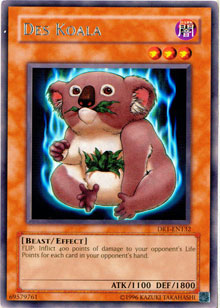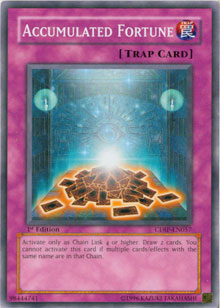About a month ago, just after Shonen Jump Championship Indianapolis 2008, I sold all my Yu-Gi-Oh! TCG cards. Not because I wanted to quit the game, but because I find that rebuilding a collection is perhaps the most fun you can have playing a TCG. The thrill of starting from scratch again is enough to sharpen your play, make you reevaluate tournament settings, and push you to interact with traders just a little bit more. (Of course, there have been drawbacks, like trying to compete with only fifteen dollars’ worth of cards!)
Whether you’re taking this enterprising approach to dueling (liquidating and rebuilding constantly), or you’re a new player looking for a cheap way to elevate your game to a tournament scene, you’ll be happy to see that today’s deck is one of humble means. With the new Semi-Limited status of Chain Strike and the release of new cards since Chain Strike Burn’s original rampage, a lot of players are taking interest.
Today we’ll be looking at a strategy that helps counteract the popular Gladiator Beast decks: making it difficult for them to complete an attack, declining to give them a decent target for Gladiator Beast Murmillo, and rarely making them happy playing Gladiator Beast Gyzarus or Gladiator Beast Bestiari. Oh, and as for their three copies of Solemn Judgment that seem to be in every deck? You’re going to have a lot of fun baiting them.
The Monster Lineup
 The monster lineup is quite small, but a select few have the speed, utility, and damage-dealing potential to make it to the decklist.
The monster lineup is quite small, but a select few have the speed, utility, and damage-dealing potential to make it to the decklist.
In the move between the Traditional and Advanced format, the copies of Cyber Jar and Fiber Jar represent the biggest difference. With three different Jar monsters that will reload your hand with enough damage-dealing power to knock out your opponent’s life points, your supply of ammunition almost never ends. The move to Advanced format might seem like a painful choice (punny), but you can move those empty slots to the trap lineup, where you can add a couple copies of Legacy of Yata-Garasu or Jar of Greed.
Reflect Bounder hasn’t previously been included in a Chain Strike Burn deck, but it’s definitely a card worth considering. It packs a whopping 1700 ATK, which is enough to run over the smaller monsters in most decks. It also has a strange effect on the way opponents will play. Often, one of two things happens when someone opens the game with Reflect Bounder: the other player either speeds up his or her game, assuming that the opponent is a poor player, or else practically halts play, assuming that he or she is playing against a volatile burn deck.
If you open the game without any other sign that you’re playing a burn deck, and can trick your opponent into thinking you’ve simply splashed three copies of Reflect Bounder into your deck (most likely a Machine variant), your opponent might simply summon Sangan or another small monster and attack the Reflect Bounder (thus, destroying it and dealing 1700 damage). You can then follow up with a full set of back-row cards and deal the remaining 6300 damage with relative ease.
The theory that governs Chain Strike Burn is the "turn 3 rule." This means that if every card you play deals an average of 1000 damage you should win by turn 3 almost every game, because you’ll have played eight cards. If your opponent freezes in the face of a Reflect Bounder—waiting for a chance to destroy it outside of battle—you’ve bought yourself some extra cards anyway.
Of course, this all discounts the fact that you might be able to attack directly with the Reflect Bounder. If that happens and your opponent is forced to attack, you’re almost guaranteed the game.
Finally, we have the three copies of Des Koala, which will normally deal 2000 damage on turn 1. If you simply set the Koala and end your turn (assuming your opponent has no previous knowledge of your deck), the normal move will be to summon a monster and attack it. If that monster has less than 1800 ATK, you’ve dealt even more than 2000 damage, which means you’ve moved the clock up to a turn 2 win instead of a turn 3 (because you’ll have six cards left to deal an additional 6000 damage on turn 2).
The Spells
The spell lineup includes maximum copies of the deck’s namesake, Chain Strike. This card is absolutely ridiculous when played well, and can deal upwards of 2000 damage with ease.
Tremendous Fire and Meteor of Destruction play an almost identical role in the deck, providing a staple 1000 damage per card. Normally, you’ll want to save them for your second turn instead of playing them on turn 1, because you’ll want to chain all your other cards to it. The Pot of Greed moves the deck a turn faster, because it offers you a way to deal an additional 1000 damage (via a free card).
The Traps
The trap lineup is the bulk of the deck, and where we find the real power. Running three copies of Reflect Bounder is good, but running six by including three copies of Zoma the Spirit is even better. That means you have a monster that can attack f or 1600 damage, with the ability of Reflect Bounder (and thus the chance to deal an additional 1600 damage or more) all packaged in a chainable trap (which means you can include it in your chain links). This is what tilts this deck from an interesting tier-two strategy all the way to a competitive tournament deck.
or 1600 damage, with the ability of Reflect Bounder (and thus the chance to deal an additional 1600 damage or more) all packaged in a chainable trap (which means you can include it in your chain links). This is what tilts this deck from an interesting tier-two strategy all the way to a competitive tournament deck.
With three copies of Accumulated Fortune and Reckless Greed, we can speed up the turn count to include a lot more turn 2 wins. The memorable Just Desserts, Secret Barrel, and Ojama Trio combination is as powerful as ever, though much depreciated by the Limitation of Ojama Trio. The three copies of Dimension Wall, one Ring of Destruction, and Magic Cylinder will safeguard you from taking a direct attack. It doesn’t matter if you take damage, as long as your opponent takes just as much!
Hopefully, this deck has either inspired a new innovation for you, or given you an excuse to join the tournament scene. Remember that with a close eye on your play, practice, and a bit of thought over what deck you’ll play, you can compete on the highest level of tournament play. Don’t be afraid to go against the grain of the metagame, and enjoy the look of surprise on your opponents’ faces when you deplete their life points in the first couple of turns.
—Ryan Murphy